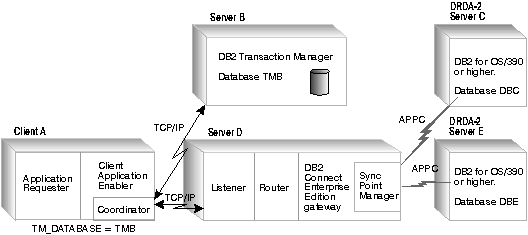
Quick Beginnings
This section describes the roles played by systems that take part in
SPM scenarios.
DB2 Connect assumes the syncpoint model defined by DRDA where only the
application requester can initiate a commit. For this reason, syncpoint
coordinator functions are included in the DB2 product that is installed at DB2
clients and servers since Version 2.1.1.
The role of the coordinator at an application requester is as
follows:
- It registers the DUOW request with a transaction manager.
- It delegates further coordination of the DUOW to the transaction manager
and the SPM.
Distributed units of work must always be registered with a transaction
manager. This is done by the coordinator at the application
requester. The transaction manager is responsible for:
- Preserving the integrity of DUOW requests.
- Providing registration, logging, and decision-making services for DUOW
requests.
- Guaranteeing the integrity of the results of the DUOW.
The SPM is always a partner with a transaction manager, which is assumed to
be at an application requester. The transaction manager can be any of
the following:
- A DB2 client/server DUOW TM
- An XA-compliant TM, such as CICS for AIX
- A DB2 for OS/390, DB2 for MVS/ESA, or DB2/400 application requester
- A host-based TP Monitor such as CICS Transaction Server for OS/390.
Notes:
- For AIX and OS/2, earlier DRDA2 support in Transaction Processing Monitors
via the Encina Peer-to-Peer Communications gateway has been replaced by the
SPM function provided with DB2 Connect Enterprise Edition Version
5.0.
- Two-phase commit is not supported through the SPM with the Tuxedo(**)
Transaction Manager.
The SPM can serve as:
- The LU 6.2 coordinator on behalf of application requesters, the
transaction manager database, and DRDA2 application servers. This is
the case when you connect from a DB2 Universal Database client to a DRDA
server, such as DB2 for OS/390, through DB2 Connect.
- An LU 6.2 participant on behalf of DB2 Universal Database servers
or DB2 Common servers. This is the case when you connect from a DRDA
Application requester, such as DB2 for OS/390, to a DB2 Universal Database
server through a DB2 Universal Database server that has the SPM
operational.
For example, when an application issues a commit, it is the transaction
manager that controls the ultimate success or failure of the commit on behalf
of the application, but it is the SPM that propagates the unit of work
decision to DRDA2 application servers involved in the unit of work.
The SPM is an independent logical unit and it communicates with DRDA
servers using APPC protocols. However, communications from DB2 clients
to DB2 Connect/SPM gateways or from a DB2 Universal Database/SPM server to
remote DB2 Universal Database servers can use any protocol supported by DB2
(APPC, IPX, Named Pipes, NETBIOS, or TCP/IP, depending on your
workstation's operating system).
Figure 20 illustrates a typical DUOW scenario. In this example the sequence
of events is as follows:
- The coordinator at Client A registers automatically with the Transaction
Manager database at Server B, using TM_DATABASE=TMB.
- The application requester at Client A issues a DUOW request to Servers C
and E. For example, the following REXX script illustrates this:
/**/
'set DB2OPTIONS=+c' /* in order to turn off autocommit */
'db2 set client connect 2 syncpoint twophase'
'db2 connect to DBC user USERC using PASSWRDC'
'db2 create table twopc (title varchar(50) artno smallint not null)'
'db2 insert into twopc (title,artno) values("testCCC",99)'
'db2 connect to DBE user USERE using PASSWRDE'
'db2 create table twopc (title varchar(50) artno smallint not null)'
'db2 insert into twopc (title,artno) values("testEEE",99)'
'commit'
exit (0);
- When the commit is issued, the coordinator at the application requester
sends prepare requests to the SPM for the updates requested at servers C and
E.
- The SPM is running on Server D, as part of DB2 Connect, and it sends the
prepare requests to servers C and E.
- Servers C and E in turn acknowledge the prepare requests.
- The SPM sends back an acknowledgement to the coordinator at the
application requester.
- The coordinator at the application requester sends a request to the
transaction manager at Server B for the servers that have acknowledged, and
the transaction manager decides whether to commit or roll-back.
- The transaction manager logs the commit decision, and the updates are
guaranteed from this point.
- The coordinator issues commit requests, which are processed by the SPM,
and forwarded to servers C and E, as were the prepare requests.
- Servers C and E commit and report success to the SPM.
- SPM then returns the commit result to the coordinator, which updates the
TMB with the commit results.
Figure 20. Two-phase Commit RDBMS Scenario

[ Top of Page | Previous Page | Next Page | Table of Contents | Index ]
[ DB2 List of Books |
Search the DB2 Books ]


